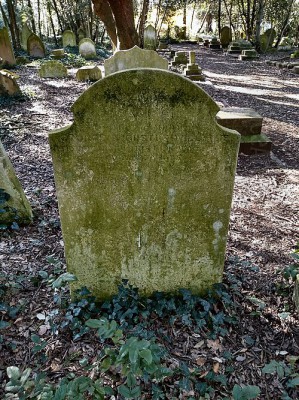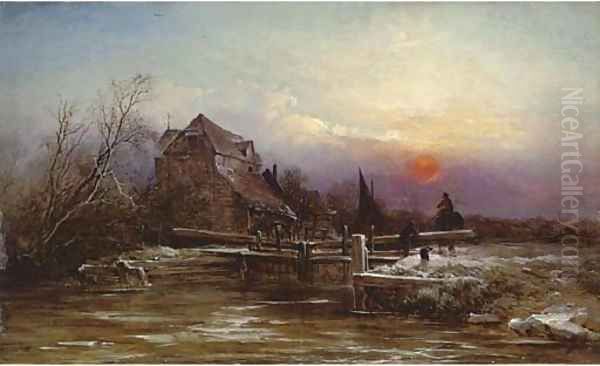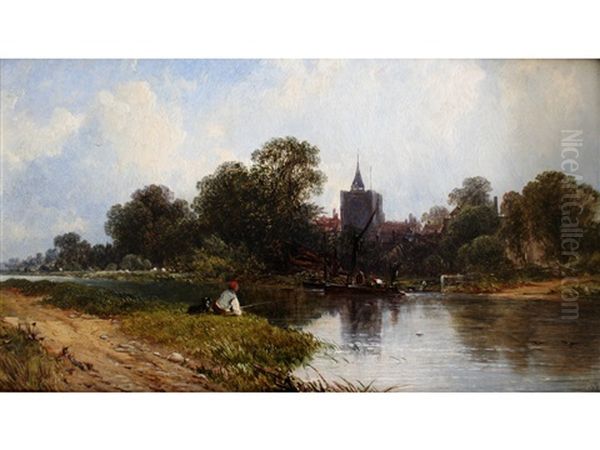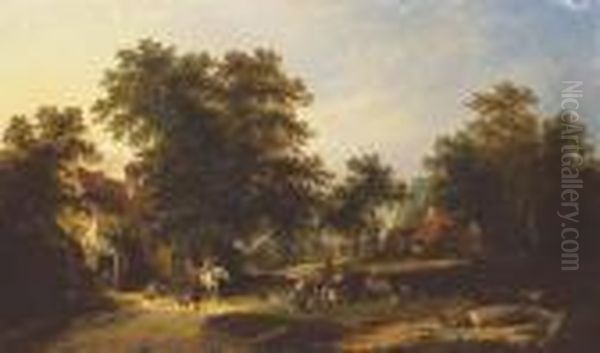
George Augustus Williams (1814–1901) stands as a significant, if sometimes overlooked, figure in the rich tapestry of 19th-century British landscape painting. A scion of the prolific Williams family of painters, he carved out his own niche, particularly celebrated for his evocative depictions of the English countryside, the tranquil moods of the River Thames, and the stark beauty of winter scenes. His work, deeply rooted in the observational traditions of his era, offers a window into the Victorian appreciation for nature, rendered with a sensitivity to light, atmosphere, and the subtle poetry of the everyday.
Early Life and Artistic Lineage
Born in the parish of St. Marylebone, London, in 1814, George Augustus Williams was immersed in art from his earliest days. He was the third son of the esteemed landscape painter Edward Williams (1781–1855) and Ann Hildebrandt. Edward Williams, himself the son of an engraver and related to artists like James Ward R.A. and George Morland, established a veritable dynasty of painters. This familial environment was undoubtedly the crucible in which George Augustus's artistic talents were forged.
The Williams household was a hub of artistic activity. George Augustus grew up alongside five brothers, all of whom would go on to become painters: Edward Charles Williams (1807–1881), Henry John Boddington (who adopted his maternal grandmother's surname, 1811–1865), Arthur Gilbert (who similarly adopted a different surname, 1819–1895), Sidney Richard Percy (1821–1886, who also adopted a different surname to distinguish himself), and Alfred Walter Williams (1824–1905). This collective pursuit of art within one family is a remarkable phenomenon in British art history, leading to their informal designation as the "Williams family of painters" or, more specifically, the "Barnes School," after the area where many of them lived and worked.
Under the tutelage of their father, the Williams brothers learned the fundamentals of landscape painting. Edward Williams senior was known for his picturesque views, often imbued with a gentle romanticism, and his influence is discernible in the early works of his sons. However, each son, including George Augustus, would eventually develop his own distinct style and thematic preferences.
The Williams Family and the Barnes School

The concentration of artistic talent within the Williams family, and their tendency to live and work in close proximity, particularly in Barnes, on the outskirts of London, led to the emergence of what is often referred to as the Barnes School. This was not a formal institution but rather a loose collective of artists, primarily the Williams family members, who shared a common artistic heritage and often depicted similar subjects, most notably the landscapes of the Thames Valley.
Living and working together, often sharing studio space in their formative years, fostered an environment of mutual learning and friendly competition. The decision by several brothers, including Henry John Boddington, Arthur Gilbert, and Sidney Richard Percy, to adopt different surnames was a practical measure to avoid confusion in the art market and to establish their individual artistic identities. George Augustus, however, retained the Williams name throughout his career.
The collective output of the Barnes School, characterized by its detailed and often serene depictions of English scenery, catered to the Victorian public's growing appetite for landscape art. This was an era when the countryside was increasingly seen as an idyllic escape from the rapid industrialization and urbanization transforming Britain. Artists like the Williams family provided visual solace and a celebration of enduring natural beauty. Their contemporaries included other prominent landscape painters such as John Constable, whose dedication to capturing the atmospheric effects of the English countryside had set a new standard, and J.M.W. Turner, whose dramatic and light-filled canvases pushed the boundaries of the genre. While the Williams family generally worked in a more traditional vein, the ambient influence of these giants was undeniable.
Artistic Style and Thematic Focus
George Augustus Williams developed a distinctive style characterized by meticulous observation, a subtle understanding of light and atmosphere, and a penchant for capturing the specific moods of different times of day and seasons. He worked primarily in oils, and his canvases often feature a rich, yet controlled, palette.
His subject matter was diverse but consistently focused on the British landscape. He was particularly drawn to:
The River Thames: Like many of his brothers, George Augustus frequently depicted the Thames, capturing its tranquil stretches, bustling riverbanks, and the play of light on its waters. His paintings of the river near Barnes, where he lived for over fifty years, are numerous and show an intimate familiarity with its character.

Winter Landscapes: Williams gained particular renown for his winter scenes. He possessed a remarkable ability to convey the crisp air, the muffled silence of snow-covered ground, and the unique quality of light in winter. These works often feature figures engaged in everyday rural activities, adding a human element to the stark beauty of the season.
Moonlit Scenes: Another recurring theme was the nocturnal landscape, often illuminated by moonlight. These paintings showcase his skill in rendering subtle gradations of tone and creating a sense of mystery and romance. The challenge of capturing the elusive effects of moonlight was one that many Romantic and Victorian painters embraced, from Caspar David Friedrich in Germany to Atkinson Grimshaw in Britain.
Coastal Views and Rural Scenery: Beyond the Thames and winter scenes, Williams also painted coastal landscapes and general views of the English countryside, particularly in Kent and Wales. These works demonstrate his versatility and his consistent ability to find beauty in a variety of natural settings.
A notable aspect of Williams's technique was his skilled use of glazes. It has been observed that he sometimes employed transparent yellow glazes to modulate the temperature of his colors, a technique that allowed him to achieve warmth in summer scenes or a particular luminosity in sunsets. This sophisticated handling of paint has drawn comparisons to the methods of J.M.W. Turner, although Williams's overall aesthetic remained more grounded in detailed representation. His brushwork was generally fine and controlled, allowing for a high degree of realism in his depiction of foliage, water, and architectural elements.
Representative Works
Several paintings stand out as representative of George Augustus Williams's oeuvre and highlight his characteristic themes and stylistic strengths:
_Winter Sunset_: This title, or variations thereof, appears frequently in connection with his work and encapsulates one of his most celebrated subjects. Such paintings typically depict the fading light of a winter's day, with long shadows stretching across a snow-covered landscape, the sky aglow with the warm hues of sunset contrasting with the cool tones of the snow. These works are admired for their atmospheric depth and poignant beauty.
_A Fisherman on the Thames_: This painting exemplifies his many depictions of life along the river. It likely showcases his ability to integrate figures naturally into the landscape, capturing a moment of quiet activity against the backdrop of the familiar waterway. The rendering of water, reflections, and the specific light conditions would be key features.

_Winter in the Village & The Snowball Fight_: This title suggests a more anecdotal winter scene, perhaps with a greater focus on human interaction and the charm of village life in winter. Such works would combine his skill in depicting snowy landscapes with a lively narrative element, appealing to the Victorian fondness for genre scenes.
_A Snowy Day_ and _Winter's Mill_: These titles further underscore his specialization in winter subjects. A mill, often a picturesque feature in the rural landscape, would provide a focal point, its structure contrasting with the softness of the snow.
_The Hurdy Gurdy Man_: This title suggests a departure into genre painting, or a landscape with a prominent figurative element. The hurdy-gurdy man was a common figure in 19th-century street life and rural fairs, and such a subject would allow Williams to explore character and social observation within a landscape setting.
His works were often signed, and many were presented in ornate gilt frames, typical of the period. They found a ready market among middle-class Victorian collectors who appreciated their accessible subject matter and skilled execution.
Exhibitions and Recognition
George Augustus Williams was a regular exhibitor at major London art institutions, a crucial avenue for painters to gain recognition and sales in the 19th century. He showed his works at the Royal Academy, the British Institution, and, most frequently, the Society of British Artists on Suffolk Street. His consistent presence at these exhibitions over several decades indicates a steady and respected career.
While perhaps not achieving the same level of fame as some of his more revolutionary contemporaries like the Pre-Raphaelites (e.g., Dante Gabriel Rossetti, William Holman Hunt, John Everett Millais) or the aforementioned Turner and Constable, George Augustus Williams was a respected and successful artist within his sphere. His work, and that of the Williams family generally, contributed significantly to the popularity of landscape painting in Victorian Britain. Their art resonated with a public that valued depictions of their native scenery, rendered with skill and a sense of quiet appreciation.
Other landscape painters active during parts of his career, whose works provide a broader context for his own, include David Cox, known for his vigorous watercolors and oils of Welsh and English landscapes; Peter De Wint, another master of the English landscape tradition; and members of the Norwich School, such as John Crome and John Sell Cotman, who had earlier established a strong regional tradition of landscape painting. Later in Williams's career, artists like Benjamin Williams Leader (no relation) continued the tradition of popular, picturesque landscape painting.
Personal Life and Later Years
In 1835, George Augustus Williams married Caroline. The couple had two children. Much of his life was centered in Barnes, a village on the Thames that provided him with endless artistic inspiration. He reportedly lived there for over fifty years, a testament to his deep connection to the area and its landscapes. This long residency in Barnes further solidifies his association with the "Barnes School" of painters.
His domestic life seems to have been stable, though touched by the sorrows common to the era. His daughter, also named Caroline, passed away in 1877. In his later years, George Augustus lived with his granddaughter, Maud Marion Williams, who was eight years old at the time of her mother's (or grandmother's daughter's) death.
George Augustus Williams continued to paint into his old age, his dedication to his art unwavering. He passed away on May 26, 1901, at the advanced age of 87. He was buried in the Old Barnes Cemetery, the same resting place as his father, Edward Williams, and other family members, a poignant symbol of the deep familial and artistic bonds that defined his life.
Art Historical Position and Legacy
George Augustus Williams occupies a solid and respectable position in the history of British landscape painting. As a key member of the Williams family of painters and the Barnes School, he contributed to a significant, if sometimes under-appreciated, current in Victorian art. His particular strength lay in his atmospheric winter scenes and his tranquil depictions of the Thames, subjects he made his own through decades of dedicated observation and skilled execution.
While the grand narratives of art history often focus on radical innovators, the contributions of artists like George Augustus Williams are vital for a complete understanding of a period's artistic culture. He and his brothers catered to, and helped shape, the Victorian taste for landscape art that was both realistic and imbued with a gentle, accessible sentiment. Their work provided a comforting vision of England's natural beauty during a time of profound social and industrial change.
In recent years, there has been a growing appreciation for the work of the Williams family, including George Augustus. Their paintings appear regularly at auction and are held in various public and private collections. Art historians and collectors recognize the quality and charm of their work, and their role in popularizing landscape painting in the 19th century. His ability to capture the nuanced effects of light and weather, particularly in his winter scenes, continues to attract admiration.
His connection to J.M.W. Turner, even if only in terms of specific techniques like glazing, is intriguing. While Williams did not share Turner's revolutionary vision or dramatic scope, his careful craftsmanship and sensitivity to atmospheric effects place him within a strong tradition of British landscape painting that valued both observation and poetic interpretation. He may not have been a pioneer in the mold of Turner or Constable, but he was a highly accomplished practitioner who excelled in his chosen genres. His contemporaries in France, such as the painters of the Barbizon School – Jean-Baptiste-Camille Corot, Théodore Rousseau, Jean-François Millet, and Charles-François Daubigny – were similarly dedicated to capturing the realities and moods of their native landscapes, reflecting a broader European trend towards naturalism and plein-air aesthetics, even if Williams himself remained more of a studio painter refining outdoor sketches.
Conclusion
George Augustus Williams was a dedicated and talented artist whose life and work were inextricably linked to his remarkable family and the landscapes of England, particularly the River Thames and the quiet beauty of Barnes. His paintings, especially his evocative winter scenes and moonlit views, demonstrate a fine sensibility and a mastery of traditional landscape techniques. He successfully navigated the London art world for many decades, producing a substantial body of work that continues to be appreciated for its skill, charm, and faithful depiction of 19th-century English scenery. As an important member of the Williams family of painters and the Barnes School, his legacy is that of a consistent and sensitive chronicler of the natural world, an artist who found enduring beauty in the familiar and shared it with a wide and appreciative audience. His contributions enrich our understanding of Victorian art and the enduring appeal of landscape painting.